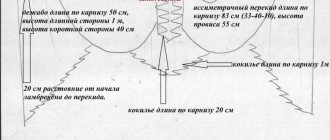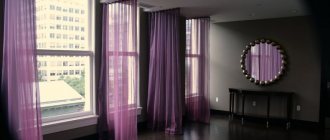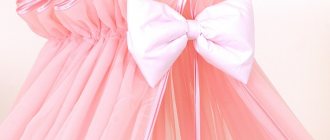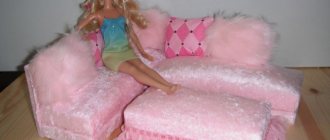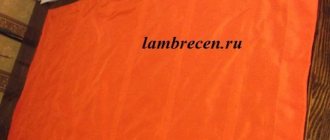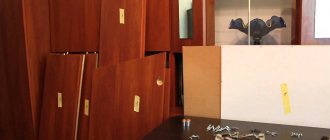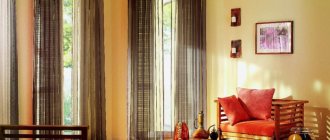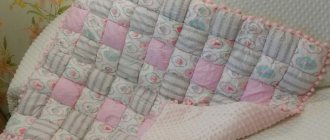Sometimes, we want to update and decorate a boring interior, but not to destroy the whole house in pursuit of major alterations. Of course, you need to strive for changes, but let them not be grandiose, because in the future you will again want novelty and experiments.
You can change the interior of a room quickly and easily; you just need to decorate the window opening. The main purpose of curtains is protection from sunlight, sound waves, drafts, wind; they also play a decorative and individual role, reflecting the taste preferences of the owners.
Elegant voile curtains will help add airiness and lightness to the room. A wide range of shades, textures, and raw materials for sewing a veil will allow you to use it to decorate any window in your home. Therefore, a voile curtain is best able to fill a room with comfort, warmth and tenderness. A light breeze will penetrate the veil and fill the room with freshness.
Floral pattern - trend of the 2018 season
How to sew curtains from a veil with your own hands
It has long ceased to be a secret that the windows in our premises play not only the role of a source of natural light - they are also an integral part of our interior and the overall feeling of harmony, peace and comfort depends on how correctly we decorate them in the room.
Learning to sew curtains from a voile
Just look at the photos below, which clearly show how easily curtains can either ruin a designer’s entire idea or, on the contrary, give it additional charm and grace. So, for example, if you want to achieve additional lightness and airiness, then for a transparent curtain you can choose a material that is popular today - a veil. By the way, in this article we want to tell you how to sew curtains from a veil with your own hands.
Rules of care
Voile is one of the low-maintenance fabrics. Before washing, soak the curtains in warm water with added powder. After two hours, rinse, drain, straighten and hang to dry.
Polyester voile curtains must be placed in a special bag before washing in the washing machine. It is advisable to choose a gentle washing mode and a water temperature of no more than 40°C.
The veil must not be wrung out. In case of hand washing, such curtains cannot be twisted.
The ironing temperature for a polyester veil should not exceed 110°C. It is permissible not to iron them at all. It is ideal if you purchase a vertical steamer.
The veil provides unlimited space for imagination and the implementation of the most daring ideas. If you take proper care of it, such curtains will give you pleasure for a very long time.
Lightweight fabric that creates a gentle cloud around the window will decorate any interior. Both demanding classics and laconic interiors in a modern style are harmoniously complemented by voile curtains.
Voile curtains are a universal design option for any window opening.
How to sew curtains from a veil with your own hands?
If you can’t find a suitable model or you don’t like the curtain options that are presented in the store, then try sewing curtains with your own hands.
As shown in the photo, voile curtains are used not only in window textiles, but also when decorating doorways
The sewing process itself is elementary. Any housewife who has already learned the art of needlework can sew beautiful curtains with her own hands. To do this, you only need desire and a little free time. Sewing curtains can be divided into several stages.
Preparation
The first thing you need to start with is searching for a curtain model and measuring the window. Think about what kind of curtains you like and whether they are suitable for this room.
Voile curtains with flowers - fits perfectly into the kitchen interior
After this, decide on the following nuances:
- model;
- textile;
- shade;
- style;
- ornament.
Go shopping to explore models and all kinds of shades of curtains, look at new products, evaluate designs and study ready-made curtain options. As a result, you will make the right choice and find something for your product. If you don’t have time to go shopping, you can use magazines to save time and effort. Next, proceed to choosing a wall or ceiling cornice; give preference to the one that will more effectively complement the style of the room.
For curtains with a veil, designers recommend using wooden curtain rods
It's time to take measurements of the window frame. Since the future curtain pattern will be based on its data. After measuring all the indicators of the window, calculate the required amount of material. Remember that if, for example, you are sewing a bandeau lambrequin, the width of the fabric should match the length of the cornice, and the length should match the distance from the ceiling to the floor.
Pattern
To sew any item, an experienced craftsman knows that it is first necessary to create a pattern. Otherwise, you risk ruining the item. The template directly depends on the measurements of the window opening and the curtain model you choose. Most novice needlewomen do not know how to make a sketch on their own, but this is not a serious obstacle when sewing curtains. Ask a seamstress you know for help or find on the Internet an example of the required curtain model with comments on its construction. Transfer all measurements to A4 sheet. Many seamstresses recommend using unnecessary rolled wallpaper as paper, but I recommend reflecting a small copy on a blank sheet of paper, and then, when transferring the template to the fabric, measure out the required dimensions.
Sewing
The first thing to do is to cut the curtains; to do this, transfer all the measurements to the fabric, leaving allowances for the seams. Markings can be applied using chalk or soap. Next, cut the necessary parts and process the ends of the curtain (iron). Then baste the stitches by hand and if you are satisfied with the appearance of the curtains, then you can sew them together. Using a sewing machine, stitch all sides of the curtains. Sew a ribbon with loops to the top edge, and finish the bottom side using a thin thread.
Although the veil material is not complicated, the stitches still need to be done carefully and slowly
Remove the basting and the bulk of the work is done.
Advice: don’t forget to sew the parts together; if you miss a small detail, you can ruin expensive fabric and waste time. Therefore, it is very important to pay special attention to fabric with various elements: colors, lines, geometric shapes. When arranging the fabric while cutting, make sure the patterns match exactly. Also, for beginners, it is better to immediately take several meters of additional fabric.
Decoration
Properly selected accessories and decor will help complement and improve your product. If your room is designed in a minimalist style, then unnecessary decorations will simply be inappropriate here.
Voile curtains themselves in such an interior will look laconic and have a complete look
However, if you still decide to decorate your curtains, then use:
- all kinds of pickups;
- magnetic decorations;
- chains, rings;
- cords and braid made of fabric;
- ribbons in the form of flowers;
- bows and tassels.
To make decorative parts with your own hands, you can use various elements: beads, flowers, shells, decorative threads, etc.
Don’t be afraid to be original and use the most unusual materials to create accessories; perhaps you will find a solution that will complement the entire interior of the room and thereby highlight your creative personality.
Tips for choosing a lambrequin
Beautiful curtains for a teenage girl’s room
If you decide to choose curtains with a lambrequin for the kitchen, it is necessary, as in any other matter, to take into account some facts that may influence your decision. We’ll talk about possible pitfalls now.
The smaller the area of the room, the simpler the lambrequins you choose should be
Roughly speaking, if you settle on a complex design, you may encounter the fact that lambrequins will attract all your attention.
The larger the lambrequin, the more total area of the room it requires and the more space it steals.
The more complex the pattern or shape of the lambrequin, the lower it makes a room with high walls.
You should also remember that almost any interior can be combined with a lambrequin, but when choosing, you should be guided by simple logic. If the design of the room is simple, then the material on the curtain should be simple and understandable
Its task is to emphasize the features of the interior, and not to draw attention to itself.
You can find patterns for lambrequins for the kitchen. The simplest options with throwing fabric over a curtain can be done by any housewife and does not require a lot of dexterity and skill. By giving free rein to your imagination, you can find a use for old curtains.
Since lambrequins will be used in the kitchen, remember the physical properties of the material. If there is an oven next to the window, or the room is small, you should think about the fact that the fabric will easily absorb odors and lose its color.
Take this into account when choosing material. Like curtains, the lambrequin must withstand washing and be equally evenly exposed to the physical effects of water and detergents.
It will be very unpleasant if the model you have chosen loses its color and gloss before the curtains do. Dull lambrequins will drag down the color of the curtains, making the overall picture dull.
Some types of woven fabric yield easily to physical stress, leaving unpleasantly protruding threads in place. If you have children or pets at home, you should consider making lambrequins less accessible.
Important points
Before you start sewing voile curtains, you need to decide on the design. It all depends on the functional purpose of the room for which they are intended:
- for the kitchen, curtains of the simplest cut are best; minimalism here will be absolutely appropriate from both an aesthetic and functional point of view;
- for a nursery it is better to sew curtains that are cheerful and bright, but it is better not to get carried away with curvaceous shapes;
- in the living room, as well as in the bedroom, the design of curtains should be carefully thought out, because it should be in harmony with the overall design of the interior and emphasize it favorably. Here, as an elegant addition to classic voile curtains, you can also create, for example, lambrequins.
If you are not sure whether you can sew complex curtains correctly, it is better to limit yourself to the simplest model. A delicate and beautiful veil completely compensates for the simplicity of the cut, and your curtains will still look very elegant. To add brightness to the interior, you can use, for example, materials in contrasting colors.
Stages of work
Before you sew curtains, you need to think about exactly how they will look. Draw a sketch, indicating each detail on it, purchase voile fabric of the desired color. Of course, the easiest way to sew ordinary straight curtains with your own hands, for which you don’t even need patterns. Following the photo instructions, do the work step by step:
- take measurements of the height and width of the window opening, calculate the required amount of material. If you want the curtains to lie a little on the floor, take fabrics 25-30 centimeters larger;
- Place the fabric right side up and align the edges. If you are using a patterned voile and are going to sew two curtains, make sure that the pattern matches;
- hem the panel from below using a thin thread;
- Sew a ribbon with loops to the top edge, with which the curtain will subsequently be attached to the cornice.
How to hem a veil for curtains
Before you start hemming the bottom of the curtains, you need to smooth the tulle well and also make sure that its edge is not wrinkled or curled. You need to step back 14 cm from the bottom of the curtain, and, hooking one thread with a needle, pull it along the bottom of the tulle. This will create a straight line along the entire bottom edge of the curtains.
The next step is to fold the fabric twice, after which the curtain must be ironed well. The last step in processing the tulle will be hemming the bottom of the curtain using a sewing machine.
To process the side edges, use a master class similar to the one above. It will be enough to step back from the edge by 3-4 cm and stretch the thread along the entire height of the curtain. Here the fabric is also folded twice and ironed, after which it is necessary to stitch the entire side edge of the tulle.
Example of curtains for the kitchen
Voile curtains for the kitchen
To make it easier for you in the future to choose sewing options for yourself, we suggest considering the option of DIY kitchen curtains made from a voile of a certain color and motif. Looking on the Internet, you can see that there are a lot of different options. We offer a specific example in which we will need the following material:
- The veil is white;
- The veil is orange;
- Bias binding for decorative elements;
- Tape for creating folds;
- Sewing machine, thread, scissors and so on.
Types of lambrequins
You can sew curtains for the kitchen with several types of lambrequins with your own hands. Among the most common available options are:
- Soft lambrequins formed by graceful folds, with a base made of the same fabric from which the curtains are sewn. This type of lambrequins usually has the simplest outlines. However, if you have enough free time, you can sew an intricate soft lambrequin with numerous folds and swags.
- A rigid lambrequin for the kitchen is able to maintain a certain shape, which is achieved thanks to the presence of a durable strip. Such lambrequins are distinguished by a wide variety of shapes and design features.
- The combined type of lambrequins organically combines the features of hard and soft products. With their help, the interior is filled with lush, elegant decoration. However, this option is not always appropriate in the kitchen.
Exquisite interior with voile curtains
Voile curtains are popular and in demand among consumers today. Why? Because this material has rightfully earned love for its translucent and smooth fabric, which is pleasant to the touch and lightweight. Voile curtains are made by weaving and joining different compositions of threads. There is a combination of artificial components with natural ones (silk or wool).
Voile curtains provide good lighting, which has a positive effect on the size of the room
Such curtains have advantages:
- The transparency and soft texture of the fabric allows the material to drape.
- Voile curtains have a fairly wide selection of colors, so everyone can choose the best option.
- To decorate such curtains, you can use embroidery, etching, and applique.
- The ability to create a unique design through the use of multi-layer veil compositions.
- Such material is accessible to most consumers.
If we compare voile curtains with organza, the voile has a dense weave, but has a soft texture. Therefore, various fastening methods are used for such curtains. This can be a special curtain tape, with which you can evenly assemble the curtain with soft folds. Some people prefer a drawstring (when the veil is not often moved along the curtain rod) or clips (clips). Some people prefer magnets (popular fastenings for lightweight fabrics) or loops.
Voile curtains are an excellent solution for decorating bedroom or kitchen windows. They help protect the room from bright sunlight, creating a unique and sophisticated interior in the house.
Description of voile curtains
The popularity of the veil is due to its beautiful appearance. This is a translucent, airy, delicate material that is pleasant to the touch. The texture of voile curtain fabric is similar to a fine mesh net. Regardless of the composition, veils include all thin, transparent materials obtained by plain weaving.
The ancient Egyptians used finely woven linen to make voile fabric. In Western European countries, before the advent of synthetics, it was made from cotton, wool or silk fibers. Nowadays the veil is obtained by weaving and connecting threads of natural and artificial origin.
Unlike organza, the veil has a dense structure and a special soft texture. As a result, as can be seen from the photo of voile curtains, they can be attached to the cornice using:
- Curtain tape.
- Kuliski.
- Clamps and clips.
- Loop.
- Magnitov.
When working with a veil, important importance is given to the correct selection of the cornice. Voile curtains look wonderful with a wall profile or ceiling cornice structure, especially if the window opening has a complex configuration.
For light curtains, it would be appropriate to use a telescopic type of cornice or a variation made from an alloy of polymer and metal.
What is a veil: composition and method of fabric production
Most voile fabrics are made by weaving very fine polyester threads. The result is an inexpensive, almost weightless canvas. Less commonly, you can find a veil made by weaving natural silk or wool fibers. This variety is considered elite and is very expensive.
The main advantages of voile curtains include:
- good ability to transmit sunlight;
- the ability to diffuse and not let bright daylight into the room;
- wide range of window design options;
- ease of care;
- low cost.
Advantages and disadvantages
The veil has the following advantages:
- Light transmission and soft texture make it possible to form beautiful folds.
- Variety of colors.
- Such curtains can be decorated with embroidery, guipure inserts, etching, and appliqué.
- The use of multi-layer voile curtains allows you to bring your wildest ideas to life.
- Affordability.
- Versatility.
- Ease of use.
- Weightlessness and smoothness.
- Visual expansion of space.
- Easy to replace.
Disadvantages include:
- Loss of original color over time.
- The veil collects dust well.
- It's quite difficult to get rid of greasy stains.
Types of veil
Often, window design includes two main elements: thick curtains and loose fabric (for example, tulle veil). The purpose of dense fabric is to cut off excess light entering the room and prevent people from viewing what is happening in the apartment from the street at night. A loose fabric (tulle voile) serves to diffuse incoming light and drape the window from the inside to create a unique mood in the room.
Tulle (large weave of threads) is used as a loose curtain The threads for them can be either natural (cotton, silk, wool) or artificial (Lurex, lycra, etc.).
Today we will look at the veil, since it has a denser texture compared to tulle and softer than organza . Today you can find a veil:
- Regular weaving.
- Microvoile or semi-organza.
You can distinguish one from the other by touch. The weaving of the microveil is close to organza, that is, in fact, it is the sister of the veil, but softer and easier to drape.
Depending on the finishing, the veil can be:
- Plain or veil with a pattern (gradient). Today you can choose the color of tulle to match any color scheme of the interior. If desired, you can choose a fabric with a color transition, which will create a special soft atmosphere in the house.
- With embroidery. If plain fabric seems too simple for you, then various types of embroidery on the veil are at your service. From light edge stitching to full fill using both fancy and floral motifs.
- With a printed pattern. If the landscape outside the window is not particularly pleasing, you can choose material with a printed pattern. Nowadays it is popular to paint landscapes (sea, mountains, forest or famous cities of the world).
- With a flat bottom or a shaped edge. You can decorate the window either with evenly flowing material or with fabric gathered into a drawstring or lambrequin. In this case, the bottom edge will be exposed, and it is very fortunate that there are materials with an edge that is elegantly decorated with embroidery or a carved edge.
The Internet and home economics magazines offer countless options for designing window openings. There are frequent cases of using not one veil fabric, but several. Being transparent, it will not overload the opening and allows you to combine even three or four panels. It looks beautiful if you combine fabrics of matching colors.
What decorative features are there?
Some experts say that you can buy beautiful curtains for the living room without a lambrequin, and they will look beautiful and elegant. In general, it’s difficult to argue with this opinion, but still, textiles look much better with this accessory.
Lambrequins should match the color of the curtain textiles
If we talk specifically about openwork decor, then it is suitable for any type of cornice without exception
It is important to note the advantages of this accessory, namely:
- very good practicality;
- wide selection of different shapes and shades;
- very easy to attach.
Lambrequins can decorate several windows at once
Another advantage of this decorative element is that it can very successfully visually change the size of the window. If you place a lambrequin over the opening and at the same time it takes up the entire partition, then in this way you will be able to lengthen the window
True, in this case it is important to choose a long cornice. In this case, the curtains frame the window, but do not cover it.
If the window is very narrow, then an openwork lambrequin is perfect for it, which harmoniously combines with the curtain fabric.
In general, there are many interesting options for how to use curtains with a lambrequin for the hall; ideas differ depending on the size of the window, the basic design of the room, the height of the window opening and much more. All these factors should be taken into account when choosing a particular decorative element.
Lambrequins will help shape the shape of the window
How is the veil hemmed?
Before you sit down to hem the bottom of future curtains, you should iron the tulle. An indent of 14 cm is made from the bottom, and then a thread is caught with a needle and pulled along the bottom.
The fabric is folded twice, then the curtain is ironed again and the bottom of the curtain is hemmed.
Curtains, as you can see, will decorate any home, making the room lighter and more spacious. Moreover, the correctly selected design of voile curtains brings special comfort to the room.
Any housewife can create with her own hands the very image that will fully correspond to all her plans.
By the way, you don’t have to be a master in sewing curtains; it’s enough to look at photos of voile curtains, corresponding master classes, and then transfer the knowledge gained to business.
conclusions
Lambrequins can be called a truly universal means of decorative window decoration.
The presence of a wide range for experimenting with the creation of forms and the availability of a variety of materials allows you to create your own unique design that attracts attention and is remembered
When choosing a style for a future lambrequin, you should rely not only on the opinion of designers, but also not forget about your own intuition and moods. Only in this way can you really choose the option that will please others.
In general, you shouldn’t be afraid to experiment, find something new, truly original, or bring fresh colors to the interior of your kitchen. In any case, over time, the result of your own labors will certainly bring satisfaction.
